
Recent Blog Posts
April 12, 2013
Upcoming Workshop Details
I’m excited to announce that I’ll be presenting a two-day intensive workshop on optimizing body composition next month in Windsor, Ontario, Canada. I’ll be sharing cutting-edge info and strategies, including the most up-t0-date research on all facets of exercise and nutrition. Topics include:
- fat loss strategies
- nutrient timing
- maximizing muscle development
- hands on exercise coaching
This will be a small group workshop limited to 20 people and is eligible for CECs. The format will allow for highly individualized attention, with extensive question and answer sessions integrated into each seminar. The early bird registration has been extended to April 24th. You can check out the details at the link below. Hope to see you in Windsor!
Optimizing Body Composition Workshop
April 7, 2013
Does Adding Aerobic Exercise to Resistance Training Increase Muscle Growth?
A number of readers have asked my opinion on the recent study by Lundberg et al. (2013), which showed that adding cardio to a resistance training routine actually increased muscle growth. I actually wrote a critique of this study several months ago for Alan Aragon’s Research Review. Alan was kind enough to grant me permission to reprint the critique on my blog. So without further ado, here’s what we can take away from the study by Lundberg et al.:
Background Info
A large body of research indicates that combining aerobic training with resistance training (i.e. concurrent training) has a negative effect on gains in muscular strength and size (9). There is evidence that aerobic exercise mediates catabolic pathways while anaerobic exercise mediates anabolic pathways. This has led to the “AMPK-PKB switch” hypothesis, which professes that the two types of exercise are incompatible (2). It has been shown, however, that considerable overlap exists in signaling responses to mechanical stimuli, calling into question the validity of this hypothesis (5).
Recently, Lundberg et al. (6) found that acute anabolic signaling markers (mTOR and p70S6K) were actually greater with concurrent training compared to resistance exercise alone. This seemingly contradicts the majority of previous research, and raises the possibility that aerobic exercise may in fact be beneficial to muscle hypertrophy. However, such results must be taken with caution as the response of translational signaling components to an acute exercise bout are often unrelated to the degree of myofiber hypertrophy seen after long-term resistance training (1). Hence, the current study was conducted by the same lab as a follow-up to this previous work, with the objective of assessing the chronic impact of concurrent training on muscular hypertrophy, strength, power, and endurance.
Study Specifics
Subjects were 10 “moderately trained” college students. The study employed a within-subject design, where participants performed resistance training on one leg while performing concurrent training (both aerobic and resistance exercise) on the other leg. The limb chosen to receive concurrent exercise was counterbalanced between subjects, meaning that for every subject who performed concurrent training on the right leg another would perform the condition on the left leg. This type of design has the inherent advantage of negating any inter-individual differences in response to training, thereby improving statistical power. Thus, the low sample size was not as big an issue as it would have been had the researchers evaluated two independent groups (although the study was still likely underpowered nevertheless).
The training program was carried out over the course of 5 weeks. Aerobic training consisted of 40 minutes of one-legged cycle ergometer exercise per session at 70 percent of peak power output. Immediately following each 40 minute aerobic bout, the workload was bumped up to near maximum peak power and subjects continued pedaling until failure (which occurred, on average, after approximately 2 minutes 30 seconds). Aerobic sessions were performed 3 non-consecutive days a week. Resistance exercise comprised 4 sets of 7 reps of unilateral leg extensions with 2 minutes rest between sets. Resistance sessions were performed 6 hours after the aerobic bout and took place 2-3 days a week (2 days/week in weeks 1, 3, and 5; 3 days/week in weeks 2 and 4). Maximal strength was assessed via isokinetic dynamometry; peak muscle torque, power, and endurance were assessed by flywheel ergometry; muscle hypertrophy was assessed by MRI as well as muscle biopsy.
The study produced some interesting findings. To no one’s surprise, the concurrent training leg showed a strong trend for greater muscular endurance as determined by time to exhaustion. Aerobic exercise requires local endurance and it therefore stands to reason that consistent cycle ergometry training would mediate specific adaptations to enhance this variable. Somewhat surprisingly, measures of strength and power were not different between conditions. Given that a preponderance of evidence seems to indicate that concurrent training interferes with strength-related gains (9), one might have assumed that the resistance-only leg would have shown greater improvements in strength/power. The most surprising finding was that muscle volume and cross sectional area in the concurrent leg was almost double that of the resistance-only leg (13.6% vs. 7.8%, respectively)! Muscle biopsy indicated that these results were primarily attributable to increases in type I fiber hypertrophy. This led researchers to conclude that aerobic exercise may provide synergistic hypertrophic benefits when incorporated into a resistance training routine without compromising functional gains attained from resistance exercise.
A Critical Analysis of Results
So what to make of these results? Should aerobic exercise be included as part of any hypertrophy protocol? Let’s dig a little deeper and see what can be ascertained from a practical standpoint…
The first thing to evaluate in any scientific study is its theoretical rationale; in other words, does the data make sense? In this case, we need to consider why hypertrophic adaptations take place in muscle tissue. The principle of specificity dictates that adaptations are specific to the stimulus applied. With respect to hypertrophy, muscles grow larger in an effort to respond to strength-related challenges. When an overload stimulus is repeatedly imposed on a muscle (such as during resistance training), it will synthesize proteins in order to meet this challenge in the future. By its very nature, aerobic exercise does not challenge the muscle in a strength-related manner, so there would be little reason for the muscle to respond by hypertrophying. In fact, hypertrophy is detrimental to lengthy aerobic-endurance exercise as it requires the body to continually support a greater load during performance. So although we should not dismiss the results of the study outright, we nevertheless must be skeptical as to their validity.
A couple of things stand out upon close scrutiny of the findings. For one, subjects were classified as “moderately trained.” By the authors’ definition, this meant that participants were involved in recreational activities such as skiing and team sports, but had not performed resistance training in the past year. So in essence, the subjects were actually untrained from a resistance training standpoint. Why is this an issue? Well, in those without training experience, virtually any stimulus will be a challenge to the musculature and thus cause hypertrophy. On the other hand, well-trained subjects have already adapted to lower-level stresses, and it therefore remains questionable whether aerobic training would provide enough of a stimulus for further muscular adaptation. It stands to reason that it would not.
Another interesting finding was that while muscle hypertrophy was deemed to be substantially greater in the concurrent leg compared to the resistance-only leg, muscle strength and power was not different between the two conditions. This seems to defy logic. Studies show a direct correlation between muscle strength and muscle CSA: a greater cross sectional area is strongly associated with greater strength (4). The fact that a greater increase in muscle mass did not lead to greater strength therefore sends up a red flag. It would seem that this contradiction is due, at least in part, to the fact that hypertrophic differences were primarily attributed to type I fiber growth. Type I fibers are endurance-related fibers with a limited force-producing capacity; it’s the type II fibers that are primarily responsible for strength and power, and these fibers showed no significant difference between groups. It seems reasonable to question whether such type I fiber hypertrophy is sustainable over the long-term. Since these fibers are highly fatigue-resistant, it could be speculated that they’d be increasingly stubborn to continued growth after an initial period of conditioning. This theory remains to be elucidated.
It also should be noted that MRI signal intensity was markedly increased with concurrent exercise but not with resistance exercise. The significance here is that an increased MRI signal intensity is consistent with an increase in tissue water content. This suggests that the greater muscle volume seen with combined aerobic and resistance exercise may well have been related to intramuscular fluid accumulation, presumably mediated by edema pursuant to muscle damage. The researchers tried to minimize this possibility by obtaining MRI scans 48 hours after completion of the final exercise session. However, peak swelling has been shown to occur approximately 5 days post-exercise (3), raising serious questions as to whether edema in fact played a role in results. The researchers downplayed any potential confounding effects from muscle damage by stating that no subject reported any soreness at the time of testing. But studies show that DOMS is not necessarily well correlated to various markers of muscle damage including maximal isometric strength, ROM, upper arm circumference, and plasma CK levels (7), making it a poor gauge of both the presence and magnitude of tissue trauma. Taking all factors into account, it appears likely that a good portion of the hypertrophic differences between conditions were related to sarcoplasmic elements rather than an increase in contractile muscle proteins.
A major limitation of the study was its short duration. One of the biggest detriments of concurrent training with respect to strength and hypertrophy is that hastens the onset of overtraining syndrome (OS). OS causes the body to shift into a catabolic state, leading to decrements in performance and impaired muscular adaptations (8). The chronic interference hypothesis suggests that the addition of aerobic exercise to a resistance training program results in long-term competing adaptations that ultimately brings about OS and thus interferes with strength-related muscular adaptations (9). Thing is, the effects of OS take time to manifest–certainly more than the five week time-course of this study. Moreover, the volume and frequency of the resistance routine employed was not very demanding, to say the least. 4 sets of knee extensions performed 2-3 days a week is no way representative of the type of routine used by most serious lifters. A higher volume routine, similar to what is customarily employed in a hypertrophy-oriented program, would place greater demands on recuperative abilities and thereby increase the potential for overtraining when combined with frequent aerobic exercise. All things considered, it is impossible to extrapolate the results of this study to long-term, higher volume training programs.
Another limitation is that the study is that a single type of aerobic exercise (cycling) was evaluated for a single muscle group (quadriceps). We cannot conclude that other forms of aerobic exercise (i.e. jogging, treadmill, stepmill, stairmaster, elliptical training, etc) provide the same effects for the quadriceps, nor can we conclude that the same effects will occur in the other lower body muscles, such as the glutes, hamstrings, or calves. In fact, evidence shows that running interferes with strength-related gains to a greater extent than cycling (9). Finally, we cannot conclude that the upper body muscles would respond similarly to upper body aerobics such as swimming or arm ergometry.
In conclusion, this study provided interesting data that challenges existing beliefs with respect to concurrent training. However, the inherent limitations of the study make it far too premature to draw any definitive conclusions on the topic. Future research should seek to examine the chronic effects of concurrent training on muscular hypertrophy over longer time periods and employing routines consistent with what lifters actually perform in real-world situations.
References
1. Adams G, Bamman MM. Characterization and regulation of mechanical loading-induced compensatory muscle hypertrophy. Comprehensive Physiology. 2012; 2829(2970).
2. Atherton PJ, Babraj J, Smith K, Singh J, Rennie MJ, Wackerhage H. Selective activation of AMPK-PGC-1alpha or PKB-TSC2-mTOR signaling can explain specific adaptive responses to endurance or resistance training-like electrical muscle stimulation. FASEB J. 2005; 19(7):786-8.
3. Clarkson PM, Nosaka K, Braun B. Muscle function after exercise-induced muscle damage and rapid adaptation. Med Sci Sports Exerc. 1992; 24(5):512-20.
4. Frontera WR, Hughes VA, Fielding RA, Fiatarone MA, Evans WJ, Roubenoff R. Aging of skeletal muscle: a 12-yr longitudinal study. J Appl Physiol. 2000; 88(4):1321-6.
5. Gibala M. Molecular responses to high-intensity interval exercise. Appl Physiol Nutr Metab. 2009; 34(3):428-32.
6. Lundberg TR, Fernandez-Gonzalo R, Gustafsson T, Tesch PA. Aerobic exercise alters skeletal muscle molecular responses to resistance exercise. Med Sci Sports Exerc. 2012; 44(9):1680-8.
7. Nosaka K, Newton M, Sacco P. Delayed-onset muscle soreness does not reflect the magnitude of eccentric exercise-induced muscle damage. Scand J Med Sci Sports. 2002; 12(6):337-46.
8. Schoenfeld BJ. The mechanisms of muscle hypertrophy and their application to resistance training. J Strength Cond Res. 2010; 24(10):2857-72.
9. Wilson JM, Marin PJ, Rhea MR, Wilson SM, Loenneke JP, Anderson JC. Concurrent training: a meta-analysis examining interference of aerobic and resistance exercises. J Strength Cond Res. 2012; 26(8):2293-307.
March 30, 2013
Random Thoughts and Notes
So much to share. Without further ado, here goes:
1. Happy to report that I will defending the research proposal for my PhD dissertation in July. This is the last step before final approval of my research project. If all goes according to plan, I will be carrying out data collection in the fall and then defend my dissertation in January, 2014. Then I can officially assume the title of Dr. Schoenfeld 🙂 Huge thanks to my dissertation chair, Dr. Brent Alvar, who has helped me immeasurably in getting to this final stage. It’s been an extremely rewarding process that has shaped my critical thinking skills in ways I never could have imagined. Very much looking forward to sharing the results of my study once finished–it will be groundbreaking work on muscle hypertrophy that should have huge implications for exercise program design.
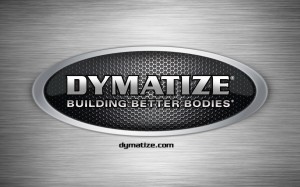
2. I am equally happy to report that I have been appointed to the advisory board for Dymatize Nutrition. For those who don’t know, Dymatize is one of the leading supplement companies in the world. What is particularly impressive about Dymatize (besides the fact that they produce the best tasting whey protein on the market, hands-down), is their commitment to advancing exercise and nutritional research. As such, they will be supporting my ongoing research efforts, which will be a huge help in facilitating my ability to carry out cutting-edge studies. I’m excited and honored to be a part of such a terrific company that is so dedicated to furthering science-based fitness knowledge.
3. I have a number of research projects currently in the works. One of them is an EMG study investigating an advanced version of the traditional plank. The exercise, which we’ve termed the Long-Lever Posterior-Tilt Plank (LLPTP), was first described by Pavel Tsatsouline of the RKC. As the name implies, it involves increasing the moment arm by placing the elbows at the level of the eyes (or as high as comfortably possible) and then initiating a posterior pelvic tilt by actively squeezing the glutes. The study from my lab is a collaboration with several prominent researchers, including my good friend and colleague Bret Contreras. Preliminary results show major increases in muscle activity compared to the traditional plank, indicating that the LLPTP can be a viable exercise for enhancing core development, particularly in well-trained individuals. I co-authored an article with Bret for the NSCA Strength and Conditioning Journal describing performance of the exercise in detail. Hoping to have published data to share soon. In the meantime, here is a video showing proper performance.
embedded by Embedded Video
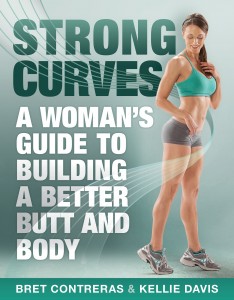
4. Speaking of Bret, he recently released his first “traditional” book sold through major retail outlets, Strong Curves: A Woman’s Guide to Building a Better Butt and Body, which was co-authored with figure competitor Kellie Davis. As I’ve often stated, no one–I’ll repeat, no one!–knows more about glute training than Bret. But while Strong Curves has lots of info on shaping up your posterior chain, it is much more than just a glute training manual. The book is over 300 pages of info on all aspects of training, including anatomy, physiology, program design, and a ton of different exercise descriptions–all in full color. I received an advanced copy and was highly impressed by the quality and scope of information covered. And although it is intended for women, the inherent principles espoused in the book certainly apply to men as well. Highly recommended reading!
5. I’ll be presenting a two-day intensive workshop on optimizing body composition next month in Windsor, Canada. The workshop will cover cutting-edge strategies for losing body fat and maximizing muscle growth. There will be both lecture and hands-on components, including sessions on metabolic resistance training, nutrient timing, hypertrophy training, and much more. The workshop will be held May 4th and 5th, with early registration extended until April 24th at a reduced rate. Hope to see you there!
6. The review article that I co-authored with my buddy Alan Aragon on the so-called anabolic window of opportunity is now the most-viewed article in the history of the Journal of the International Society of Sports Nurtition! The article has now been viewed almost by almost a hundred-thousand readers. Pretty amazing that all this has transpired in only two months of publication. Alan and I are very proud of this paper, as it presented evidence challenging a dogma that had existed for decades in the fitness field. The results of the most-viewed JISSN articles can be seen here.
7. Lastly, I wanted to share another video clip from my recent appearance at the NSCA Personal Trainer Conference. Here I discuss whether deep squatting is detrimental to the knee ligaments, and delve into the implications for program design. Enjoy!
embedded by Embedded Video
Until next time, cheers!
Brad
March 20, 2013
NSCA Personal Trainer Conference 2013 Recap: Part 2
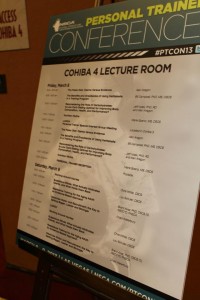
Day 2 of the 2013 NSCA Personal Trainer Conference, held on Saturday, March 9, was as eventful as Day 1 (for a full review of Friday’s events, see my previous post). For me, it was even more so. I presented twice: at 9 am and again at 2 pm. Given my speaking schedule as well as the fact that I had a number of NSCA-related meetings throughout the day, I unfortunately missed out on several sessions that I really wanted to see including presentations by Lou Schuler, Nick Winkelman, and Martin Rooney. Nevertheless I was able to attend a number of excellent lectures. Here’s the lowdown.
First session of the day was presented by Jim Kielbaso, a top-level strength coach who specializes in training athletes. Given Jim’s background, his topic was very appropos: “Should You be Training Your Personal Training Clients Like Athletes?” Jim is a very polished speaker and his lecture was peppered with personal anecdotes from working with numerous players in the NFL and NBA. As Jim noted, most people couldn’t care less about gaining extra few inches on their jump height or decreasing their sprint time by a couple of seconds. All they want is to look better and be healthier. The take-home message here was that you should never inflict your own biases when training a client. In this regard, the fitness goals of a stockbroker, truck driver, and housewife will invariably be different than that of an elite athlete. Accordingly, they will require a different training approach than if you were working with Michael Jordan.
Next up, my session on “The Science of Squatting.” Squatting biomechanics has become one of my fitness hobby-horses. In 2010, I published an article in the Journal of Strength and Conditioning Research titled, Squatting kinematics and kinetics and their application to exercise performance.” The article extensively reviewed the literature on squats, and made practical recommendations for optimal performance. Subsequently, I wrote several articles for NSCA publications on the controversy over deep squats, including a point-counterpoint position statement in a recent issue of the Strength and Conditioning Journal. My lecture at the Personal Training Conference covered a variety of topics. I began by detailing the applied anatomy and kinesiology for each joint involved in the squat, and then delved into an array of performance-related issues including bar placement, gaze, stance, knees-over-toes, and of course, squat depth. A big debt of gratitude to Bret Contreras and Alan Aragon for introducing me–the dual introduction was an NSCA first. I was humbled by their sentiments as they are two of the people I respect most in the field. Here is a clip from my presentation.
embedded by Embedded Video
Following my presentation, I went to check out the lecture by Dr. Brent Alvar–one of the world’s leading strength and conditioning researchers–who spoke about evidence-based resistance training. Brent is not only a good friend, but he is also one of my mentors. He serves as the chairperson of my PhD dissertation committee, and has furthered my advancement as a research scholar. I owe him a huge debt of gratitude. In this lecture, Brent focused on training elderly adults as a means to discuss evidence-based practice. What impresses me most about Brent is that he isn’t just a lab geek. Rather, he has held positions as a personal trainer, strength coach, facility operator, and pretty much every other job you can think of in the field. The insight into practical application was readily evident in his presentation. Brent outlined a systematic approach to program design, discussing how to begin with a review of literature and then apply the information to the individual client by using logic and experience. As Brent made clear, a well-designed regimen will always be a blend of science and art; but you can’t be an artist without knowledge of the existing evidence.
The final session I attended was given by Chad Waterbury. Chad’s presentation was titled, “Maximize Motor Unit Recruitment: the Key to Getting Bigger, Leaner and Stronger.” This was the first time I’d heard Chad speak and it’s no wonder he’s such a popular fitness pro. His delivery was smooth and he displayed a clear confidence in the material. He provided definitive opinions on the best methods for maximizing motor recruitment, and discussed how this related to optimizing strength, power, and endurance. He concluded the presentation by explaining ways to incorporate his methods into program design, delving into the specifics of sets, reps, and frequency.
Summing up, this was an incredible conference in every facet. Big thanks to the NSCA for putting on such a well-run event. Looking forward to the National Conference in July…back in Vegas 🙂
Cheers!
Brad
March 14, 2013
NSCA Personal Trainer Conference 2013 Recap: Part 1

The 2013 NSCA Personal Trainer Conference was held at the newly renovated Tropicana Hotel in Las Vegas. The conference took place over two days: Friday March 8 and Saturday March 9. I was slated to speak on Saturday. My topic: The Science of Squatting.
I arroved in Vegas around 11 pm Thursday evening after teaching a kinesiology class until 4:30 pm EST. I’m in New York so the flight is 5 hours with a 3 hour time difference. To say I was jet lagged upon arrival is akin to saying the Ronnie Coleman is somewhat muscular. Didn’t matter. I was stoked for the conference.
For those who’ve never been to an NSCA event, the quality of speakers and topics is always top notch. I’ve attended every NSCA Personal Trainer Conference for the past decade; this was without question the best line-up of presenters ever assembled.
Sessions ran from 8 am to 5 pm on the hour with a lunch break from 12-1 pm. Each session lasted 50 minutes.
The format of the Personal Trainer Conference allows for each speaker to present the same topic twice in a given day; once in the morning and once in the afternoon. Four speakers are presenting at any one time, so this affords attendees two opportunities to see a presenter of interest. Still, even if you go to as many sessions as possible, you will still miss out on some presentations. Because of these limitations, I unfortunately was unable to attend the sessions of a number of excellent presenters. These included uber-trainer Jay Dawes, speed-training guru Loren Landau, nutrion expert Marie Spano, the always innovative and creative Nick Tumminello, Alwyn Cosgrove, Phil Kaplan, Robert Linkul, JC Santana, Fraser Quelch, and a few others. What’s more, Lou Schuler, Nick Winkelman, and Martin Rooney all presented at the same time that I did, so unfortunately I missed out on these sessions as well.
So with this as background…what follows is my overview on what transpired. I’ve divided the post into two parts. Here I’ll go over Friday’s events; in Part II I’ll cover Saturday.
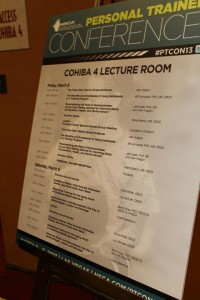
The first session I attended on Friday morning was by my good friend and colleague, Alan Aragon. I had the pleasure of introducing Alan here, and noted that he is as knowledgeable about nutrition as anyone in the field. Just as importantly, he understands practical application of nutritional principles to real-world dietary practices. This is a skill that’s lacking for many in the field. Alan’s topic was titled, “The Paleo Diet: Claims Versus Evidence.” He systematically took apart all the claims of the diet, discussing logical fallacies and flaws in the interpretation of research. The overriding point was not that there is anything inherently wrong with the diet itself, but rather that it is not the be-all-end-all way to structure a nutritional regimen. Chalk one up for science 🙂
The second session of the day was given by Dr. Len Kravitz, a professor in the exercise physiology department at the University of New Mexico. I’ve known Len for years and he is without question the most polished speaker on the fitness circuit today. His energy and enthusiasm are contagious. His content superb. His powerpoints unsurpassed. I’ve often joked that Len could recite the alphabet and make it interesting. In this lecture he discussed various strategies to enhance metabolism. One area of focus was non-exercise activity thermogenesis (NEAT). Simply stated, NEAT is every activity you do other than formal exercise, and even includes things such as fidgeting. A take home point Len made was to incorporate regular “NEAT breaks” where you get up from your chair and just take a walk around. Doesn’t sound like much, but research shows that this alone can burn a significant number of calories. He also discussed performing metabolic circuits for fat loss. These included some novel exercises, demonstrated in video clips by strongman competitor Jonathan Mike. As expected, an overall terrific presentation.

Next up came an eagerly anticipated session: the debate between Alan Aragon and low-carb research expert Jeff Volek titled, “Reconsidering the Role of Carbohydrates: Is Low Carb Dieting Optimal for Improving Body Composition, Health, and Performance?” Alan did an excellent job reviewing this session on his blog here so I won’t rehash what transpired. Instead, I’ll offer my opinion of the debate. Although both speakers did an excellent job presenting their positions, my take after seeing both the morning and afternoon sessions is that Alan had the clear advantage from an evidence-based standpoint. He was able to refute virtually all of Jeff’s points, and make a strong case that carb intake should be based on individual needs with most doing well with moderate consumption. I’ll also note that I had a chance to speak to Jeff following the presentation. He told me that his primary interest in low carb diets deals with those who are either diabetic or pre-diabetic. He conceded the diet is not ideal for gaining muscle and said he doesn’t feel it confers any advantage over non-ketogenic from a weight loss standpoint. As reflected both in the literature and through experience, optimum nutrition is highly individualized. I predict that nutrigenomics is our future, where diets will be customized based on a cheek swab of a person’s DNA. The technology is already here. It just needs to be perfected. That day is coming, perhaps soon.
The final session before lunch was given by my good friend and frequent collaborator, Bret Contreras. Bret is affectionately known as “The Glute Guy.” And for good reason. No one, bar none, knows more about the gluteals and their form and function than Bret. Heck, he’s doing his PhD on the topic! Not surprisingly, Bret’s presentation was titled, “The Science of Glute Training.” Despite knowing Bret for years, this was actually the first time I had the priverlege to see him speak. He didn’t disappoint. Bret has a unique presentation style. His sense of humor balances high-level technical content. He covered a wide array of topics on the glutes, including their five major roles and the varying torque angles associated with different glute exercises. What I found most interesting were the many tidbits of info Bret provided as to how train the muscle for optimal strength, power, and muscular development. The perfect blend of science and application.
Following lunch, I stopped in to see Joe Dowdell’s presentation, “Structuring the Training Session for Optimal Results.” Joe is one of the top trainers in the industry. His knowledge of programming is vast and backed by years of practical experience. Joe’s session was a “hands-on” presentation where he actively took attendees through his recommendations. This included various warm-up and activation activation drills, as well as specific exercises designed to enhance improvements in body composition. Very useful info.
The final session of the day was “Benefits and Drawbacks of Using Kettlebells in a Training Program” by Dr. Bill Campbell. Bill is a noted professor and researcher at the University of South Florida in Tampa. As you might expect, his presentation was a research-based analysis on the use of kettlebells. Bill did an excellent job overviewing the peer-reviewed literature investigating kettlebells as a modality. It was a balanced lecture that touched on the implications of using kettlebells to improve body composition, strength/power, metabolism, and low back pain. The evidence is still evolving on the topic, and Bill highlighted directions for future research.

Following Friday’s sessions, there was a social by the pool where all attendees and speakers got to mingle and network. Had a glass of Cabernet…or perhaps two. It was great to get a chance to meet a lot of trainers who I’ve corresponded with through social media but had never spoken to personally. I then went to dinner with a number of friends including Bret Contreras, Alan Aragon, Joe Dowdell, Dan Trink, Nick Tummniello, Lou Schuler, and Chad Waterbury. A power-gathering of fitness pros if there ever was one.
It was an action-packed day. Fortunately, there was still another full day of presentations to come as well as my own lecture. More on that in the next post.
Cheers!
Brad
March 2, 2013
The Role of Metabolic Stress in Muscle Growth
I recently published a review article in the prestigious journal, Sports Medicine, titled, Potential mechanisms for a role of metabolic stress in hypertrophic adaptations to resistance training. This is one of the most interesting and exciting areas of hypertrophy study, and it is a primary focus of my own research.
It has been well documented that mechanical tension associated with resistance exercise promotes hypertrophic gains. The forces associated with lifting weights alone are therefore capable of producing muscular growth. What is becoming increasingly clear, however, is that metabolic stress associated with moderate to higher repetition exercise also can promote increases in muscle mass. The mechanisms by which this occur are still not entirely clear, but recent research is beginning to give us insight into the possibilities. As discussed in my recent review, several potential factors have emerged as likely candidates. For those who want the cliff notes, here is an overview of each:
Fiber Recruitment: Perhaps the most established way that metabolic stress appears enhance growth is by increasing recruitment of fast-twitch (i.e. type II) muscle fibers. Recruitment follows the so-called “size principle” whereby the smaller slow-twitch (i.e. type I) fibers are recruited first during muscular activity and then larger fast-twitch fibers are progressively called into play as needed to carry out the action. It is believed that the effects of metabolic stress promote fatigue of slow-twitch fibers, thereby forcing activation the fast-twitch fibers. Understand that fibers must be recruited in order to grow; without such stimulation, there is no impetus for the fiber to adapt. Thus, increased recruitment enhances the growth potential of the muscle as a whole.
Myokines: Another possible means by which metabolic stress may enhance muscle mass is by increasing production of local growth factors. Muscle tissue directly produces a number of growth-promoting substances, which have been termed myokines. Local production of a variant of insulin-like growth factor, called mechano-growth factor (MGF), is thought to be particularly important to muscle development and metabolic stress has been shown to increase its production. Numerous additional myokines have also been implicated in the growth process including various interleukins, fibrobrast growth factor, hepatocyte growth factor and others–and many of them appear to be regulated, at least in part, by metabolic stress. Moreover, there is evidence that metabolic stress may reduce various catabolic factors, ultimately increasing the extent of muscle protein accretion.
Reactive Oxygen Species: The term reactive oxygen species (ROS) generally conjures up negative images. The popular media has demonized ROS as injurious substances that wreak havoc on bodily tissues, causing disease and even death. While this view has some credence with respect to chronically elevated levels of ROS, their acute production following exercise has actually been shown to confer positive effects on muscle development. Specifically, ROS are thought to function as key cellular signaling molecules that promote muscle anabolism. There is evidence that metabolic stress heightens ROS production, potentially helping to increase hypertrophy.
Cell Swelling: One of the most novel mechanisms by which metabolic stress may promote muscle growth is via an increase in the hydration of the muscle fiber. This phenomenon, known as cell swelling, has been found to increase protein synthesis and reduce protein breakdown. Well, it just so happens that metabolic stress is a causitive factor in cell swelling, largely from the corresponding accumulation of lactate. Lactate acts as an osmolyte, attracting fluid into the muscle cell. This, in turn, causes sensors in the cell to perceive a threat to its integrity, thereby initiating a signaling cascade that ultimately enhances anabolism.
Acute Hormonal Elevations: This is one of the more controversial areas of research. Studies clearly show that bodybuilding style training (i.e. multiple sets of moderate reps with fairly short rest intervals) substantially increases post-exercise anabolic hormonal levels. What is less clear is whether these transient hormonal spikes actually play a role in the growth process. Evicence is conflicting and there are large gaps in the literature making it difficult to draw firm conclusions on the topic. I have a review paper just published-ahead-of-print that specifically addresses this topic; I’ll have more to say about it soon. Stay tuned…
Summing up, there is compelling evidence that metabolic stress can serve to augment muscle growth. Although we have yet to fully understand precisely how this occurs, it would appear that a combination of factors detailed above are involved in the process. Note that these mechanisms remain largely theoretical at this time, and there may well be others that have not yet been determined.
So how can you use this information? From a practical standpoint, metabolic stress is heightened during resistance training protocols that involve moderate to higher repetitions and fairly short rest intervals. This is typical of the common “bodybuilding-style” method of training and if your goal is to maximize hypertrophy, it appears prudent to include such training as a primary component of your routine. What is not clear as yet, however, is whether metabolic stress provides an additive benefit over-and-above what can be achieved by simply training with very heavy loads. My lab will be exploring this topic over the coming months and I hope to be able to provide some answers in the near future. Stay tuned!
Brad
February 15, 2013
Nutrient Timing Revisited: The Anabolic Window of Opportunity
I recently co-authored a review article with my good friend and colleague Alan Aragon titled, “Nutrient Timing Revisited: Is there a post-exercise anabolic window?” I’m happy to say the article was published in the prestigious Journal of the International Society of Sports Nutrition and has received a lot of favorable attention. Here are the highlights:
1) Nutrient timing can be a beneficial strategy for maximizing muscular gains, but the “window of opportunity” is not necessarily as narrow as often believed.
2) Provided that a protein-rich meal is consumed within about 3-4 hours prior to a workout (or possibly even longer, depending on the size of the meal), you don’t have to stress about chowing down a post-workout meal as soon as you finish training. For those who train partially or fully fasted, on the other hand, consuming protein immediately post-workout becomes increasingly more important to promote anaoblism.
2) Although research is somewhat equivocal, it seems prudent to consume high-quality protein (at a dose of ~0.4-0.5 g/kg of lean body mass) both pre- and post-exercise within about 4-6 hours of each other depending on meal size.
3) Contrary to popular belief, consuming post-exercise carbohydrate does not meaningfully enhance anabolism. Moreover, unless you are performing two-a-day workouts involving the same muscle group(s), glycogen replenishment will not be a limiting factor in those who consume sufficient carbohydrate over the course of a given day. So from a muscle-building standpoint, just focus on meeting your daily carb requirement as opposed to worrying about timing issues.
One of the most surprising aspects of writing this paper was the lack of clarity in the current body of research. Alan and I reviewed every direct study conducted on the subject. Not only were results of these studies highly conflicting, but most had confounding issues that obscured the ability to tease out the impact of the effects of consuming nutrients post-workout. I am planning a study in my lab that addresses the gaps in the literature. Hope to begin data collection in the near future. Stay tuned!
In case you want to delve into the heavy science on the topic, here is a link to a PDF of the article:
Nutrient Timing Revisited: Is there a post-exercise anabolic window?
Cheers!
Brad
October 29, 2012
MAX Muscle Podcast
Here is a podcast that I did with my publisher, Human Kinetics, discussing aspects of my new book, The MAX Muscle Plan. It’s a wide-ranging interview where I delve into topics such as:
Click on the arrow below to listen to the podcast:
October 6, 2012
This and that…
Lots to talk about and share. So without further ado…
An Interview With Brad Schoenfeld – The Hypertrophy Specialist
And here is an interview I did with fitness marketing guru Jon Goodman. This one is a bit lighter than the interview I did with Bret, but there’s a lot of good take-away training info, nonetheless.
Max Muscle: A periodized approach to optimizing muscle hypertrophy
The second is a three-hour hypertrophy seminar that will explore the mechanisms of muscle growth, their application to training, and how to put this information into practice with respect to program design. The seminar is being hosted by Innovative Wellness Consulting and will be held at the American Academy of Personal Training, 138 West 14th Street, NYC on Friday, November 16. Here is a link for registration:
embedded by Embedded Video
.youtube.com/watch?v=CS9X0-GUJS4&feature=plcp
September 28, 2012
The MAX Muscle Plan
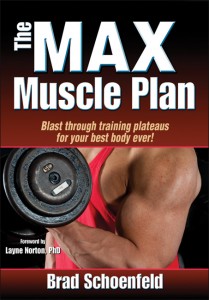
I’m thrilled and excited to announce the release of my new book, The MAX Muscle Plan. The book outlines a 6-month periodized program to maximize muscle development. It is the culmination of many years of research and experience, blending the science and art of exercise program design for optimal gains. Every rep, set, and rest interval is mapped out, with complete discussions as to how to individualize the routine for best results. There also is a entire chapter devoted to nutrition for muscle growth–an essential aspect of any muscle-building program. A big thanks to Layne Norton for writing the forward to the book, and to Alan Aragon for reviewing the nutrition chapter.
Here is a link to check out the book on Amazon.com, who is offering it at a significant discount. If you have any questions about it let me know!





 Entries (RSS)
Entries (RSS)



